Abstract
This paper presents the optimization sizing of a battery energy storage system for residential use from load forecasting using AI. The solar rooftop panel installation and charging systems for electric vehicles are connected to the low-voltage electrical system of the Metropolitan Electricity Authority (MEA). The daily electricity demand for future load forecasting used the long short-term memory (LSTM) technique in order to analyze the appropriate size of the battery energy storage system (BESS) for residences. The solar rooftop installation capacity is 5.5 kWp, which produces an average of 28.78 kWh/day. The minimum actual daily load in a month is 67.04 kWh, comprising the base load and the load from charging electric vehicles, which can determine the size of the battery energy storage system as 21.03 kWh. For this research, load forecasting will be presented to find the appropriate size of BESS by considering the minimum daily load over the month, which is equal to 102.67 kWh, which can determine the size of the BESS to be 17.84 kWh. When comparing the size of BESS from actual load values with the load from the forecast, it can significantly reduce the size and cost of BESS.
1. Introduction
To study the method of meeting the energy demand for residential use, mainly by using the energy generated from the solar rooftop system installation as shown in Figure 1, the selection of a battery energy storage system suitable for residential use in the case of solar rooftop installation is carried out using the developed software, which uses the residential load data to determine the most suitable solar rooftop system [1]. The battery energy storage system suitable for residential use, in the case of solar rooftop installation, can be applied to different scenarios to optimize the battery usage data with different renewable energy sources, and the solar rooftop model is developed to work with the grid system. The grid system can be tested under standard test conditions using MATLAB/SIMULINK [2,3].
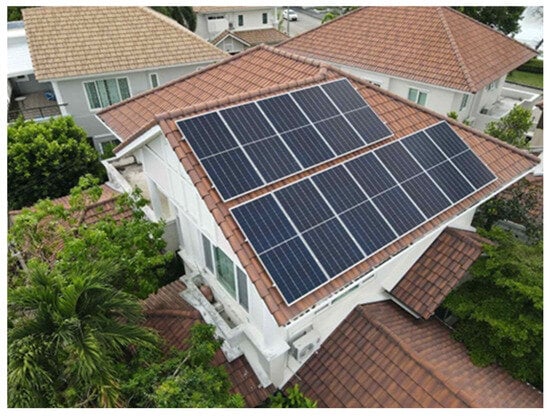
Figure 1.
Solar rooftop installation of 5.5 kWp.
It is possible to effectively reduce the fluctuation of new energy and reduce the impact on the power system by proposing a simple method that requires the measurement of increased conductivity to directly control the power from the solar rooftop system [4,5,6]. Nowadays, the use of electric vehicles has become widespread, so it is necessary to study the relationship between electric vehicles and regular charging. It can use the dataset of charging at different locations, including each parameter, as well as the relevant charging time. The dataset includes information on the arrival and departure times of electric vehicles. The dataset collected from charging stations which meet the charging demand at different locations is used in the methodology and evaluation of electric vehicle (EV) charging models [7,8,9], affecting the availability of electric vehicles while maximizing the electricity generation from solar rooftop PV using EV batteries [10]. In this case study on the load impact for EV charging, a modeling framework is developed to utilize useful information from real EV charging event data and residential electricity consumption data [11,12].
EV charging is considered in conjunction with solar rooftop power generation. It provides both charging and discharging power for electric vehicles connected to the 50 Hz AC grid. Solar rooftop power is the primary power source for the EV charging system in conjunction with grid connection. It is generated using photovoltaic (PV) panels located at different locations, where the panels may be mounted on the roof or as a rooftop on a building. The energy consumption and capacity data of the EV are determined by the EV data, which can be used to describe and generate data on the charging time of the EV [13,14]. Considering the expected developments by 2030, the value of EVs can be improved by improving the design of the power system and charging strategies of both the power system and the EV usage level. These optimizations are balanced by using real-time electricity prices and efficient demand responses of the electrical load [15,16,17]. The proposed new approach uses a multi-stage optimization strategy that considers both the routing of the EVs and the overall energy management of the EVs in the power system. Each EV is used to determine their charging. Therefore, the optimal scheduling of EV charging is an extraordinary problem involving multiple sources of uncertainty. These uncertainties are often overlooked in demand management [18,19]. However, considering the demand management aimed at exploiting the flexibility of EVs, an optimal control theory has been proposed to determine the optimal battery energy storage system usage for the residential and solar rooftop installation cases. This study provides recommendations on the relevant framework conditions as well as the optimal sizing of the power grid for the best economic and technical results. The application of the optimal parameter set shows that the sizing of the power grid can handle these problems well, thus providing accurate results with fast computational speed. The analysis of battery efficiency and lifetime as a concept for sizing EV charging stations has been extensively studied [20,21,22]. The calculations from the models must take into account the load profiles of residential energy usage, the solar rooftop system, and the battery so that the simulations can have high energy potential and further reduce energy consumption, unlike those observed in conventional models with solar rooftop and batteries [2,23,24,25,26]. For residential load forecasting using LSTM, the focus is on the impact of parameters on the forecasting performance, such as training data size and model accuracy. It has been shown that LSTM improves the load forecasting accuracy and energy management of the grid [27]. The load forecasting using LSTM is reliable for forecasting, with a comparative analysis based on the accuracy and efficiency metrics conducted [28]. The study utilized federated learning, transfer learning, and deep dynamic threshold compression to improve prediction accuracy in response to high data masking and dimensionality [29]. However, the predictive demand forecasting and real-time scheduling can optimize energy use [30,31].
Artificial intelligence (AI) techniques and optimization techniques have emerged as promising strategies in the pursuit of sustainability, with efficient AI in centralized LSTM. There are customizable modeling methods for data analysis and optimization. Effective applications of AI include machine learning, deep learning methods, and LSTM [32,33] to manage the limitations of current methods in forecasting, optimization, and control. Integrating these diverse approaches for better forecasting and management addresses the need for explainable AI in critical decision-making, which is being widely used with the rise of AI [34,35,36,37,38]. The principles and tools of the proposed explainable AI support the design and validation of models, while further customization of the system with regard to input data preparation, feature selection, and model implementation is possible [39]. However, to gain a deeper understanding of the forecast results and quickly respond to uncertain situations, and since practical engineering requires high standards of forecast reliability, interpretable deep learning methods have been proposed to solve multi-stage residential load forecasting problems, called explainable AI, to further improve their efficiency [40,41]. The use of AI has been investigated and evaluated using standardized datasets. Machine learning (ML) studies are continuously being improved through the use of training data and the exploitation of available, fully interconnected scenarios. In general, it has become a major research issue in the field of artificial intelligence. AI-driven technologies that exploit the ability of computer techniques to decode and understand have become the leading approach in forecasting. As a result, the development of machine learning methods that can provide accurate forecasting is a major issue [42,43,44,45,46]. Currently, environmental concerns are widespread all over the world, and solar power plays a major role in this discussion. Therefore, accurate forecasting systems are needed to improve the quality of the processes used in energy production. The data are situational, so the modeling and forecasting process using AI is important [47]. However, traditional and probabilistic methods are less adaptable to changes in demand and trends. With the development of AI, these new methods have become the most popular option due to their higher accuracy based on extracting features based on time, demand, and trends [48]. In recent years, it has been proposed that AI controllers, combined with deep learning techniques, be applied as advanced controllers that can achieve this goal. Due to the advancement of AI technology, intelligent diagnosis technology has been applied. This study developed an artificial neural network, LSTM, to diagnose the fault. Most traditional AI-based fault location methods rely on the selection of fault values. In addition, these methods are often very sensitive to the selected fault parameters and characteristics, so the efficiency of the conclusions is high [49,50,51,52]. AI, such as machine learning (ML) and supervised learning (SL), has been widely used by practitioners, and academic research projects have also been carried out in various domains. However, the use of machine learning in operational forecasting is still limited for this reason [53]. AI techniques such as LSTM are used in this study for forecasting [54,55].
LSTM can model these time-dependent relationships, exploiting historical sequences of data to identify patterns and trends. This indicates that LSTM are particularly effective at identifying cases where outcomes are true positives, making them a reliable candidate. The use case is to operate on data with a simple LSTM network [35,36,37,38,39]. An LSTM model is used, with an input gate, a forget gate, and an output gate as the three gates of an LSTM unit. The input gate determines how much input data is needed to be retained in the existing state of the memory unit, the forget gate is the basic design for LSTM to learn long-term dependencies, and the output gate decides which state of the memory cell is to be sent to the hidden output state [45,50]. The recurrent neural network (RNN) is widely used in natural language processing (NLP) and time series forecasting, and improved methods have been proposed, particularly LSTM [51,52,54,56].
Root Mean Square Error (RMSE) is defined as the average deviation of the estimate from the observed value [57]. RMSE is used to assess the difference between the predicted and actual values to check the forecast accuracy of the model. The results show that the proposed approach provides more accurate forecasts and the lowest RMSE values. The research emphasizes its application in energy yield prediction, which can improve the supply and demand balance in the electricity network. The success of experimental results and artificial neural networks is determined by RMSE [58,59,60]. RMSE is used to measure the variability of the data; the smaller the value, the better the model accuracy [61]. In addition to RMSE, the error regression curve obtained from MATLAB was used to evaluate the network performance and the results of the validation of the adequate predictions of the trained ones [62].
In 2025, the number of electric vehicles worldwide is expected to exceed 85 million, which will significantly increase electricity demand and generate interest in using solar roofs and batteries as a power source for charging electric vehicles to reduce dependence on the main electricity grid. Therefore, studying the size of batteries used to store electricity for residential use is a challenge. Finding the right size will help to use energy efficiently and reduce energy costs in the long run, especially when it is necessary to charge electric vehicles in residential homes. This research focuses on calculating the appropriate battery size for residential use in cases where electric vehicles need to be charged, using artificial intelligence techniques to calculate the best value for installation in residential homes. This research will be important in helping to increase the sustainability of energy use and respond to the increasing demand from the use of electric vehicles in the future.
2. Methodology
2.1. Long Short-Term Memory (LSTM)
LSTM is able to model these temporal relationships is shown in Figure 2, leveraging historical sequences of data to identify patterns and trends [35]. LSTM, a variant of RNN, is designed to handle long-term data dependencies. A central unit called a state cell acts as a memory, retaining relevant information while discarding unnecessary information. This structure allows LSTM to process historical data more efficiently than standard RNN, making it ideal for electrical load forecasting. Recent developments in LSTM-based algorithms have provided robust models for electrical load forecasting. LSTM is designed to handle long-term dependencies and reduce potential problems in standards [48,49].
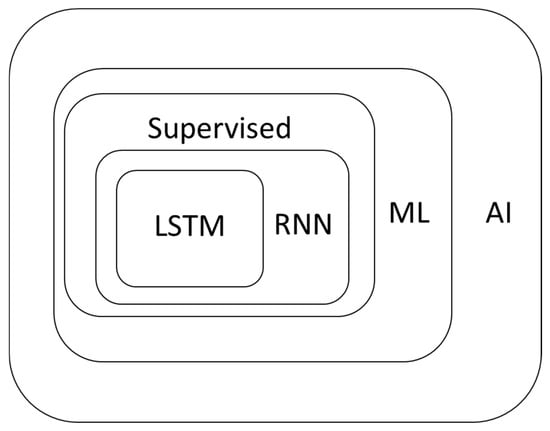
Figure 2.
AI model for LSTM.
The structure of LSTM for long-term and short-term data relationships is shown in Figure 3. The forget gate layer will determine the information to be discarded from the previous output gate layer and the current input gate layer. To process the output gate layer, it will be multiplied by the cell state, while the input gate layer will determine the new information to be stored in the cell state.
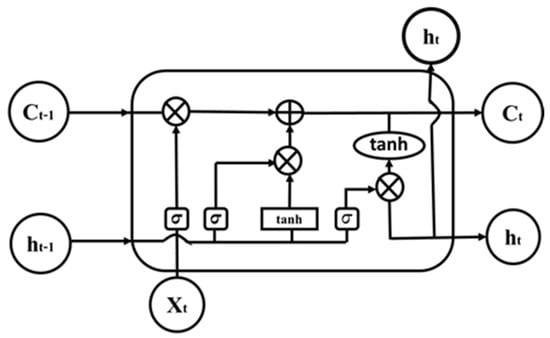
Figure 3.
Structure of LSTM.
2.1.1. Forget Gate Layer
The forget gate layer is a gate responsible for determining whether the incoming data in the cell should be kept or discarded. The decision to keep the data is evaluated based on the input data that comes into that node, along with the results from the previous node’s calculations. The equation is shown as:
where:
- is denotes the forget gate control signal;
- is about the hidden layer weights of state vector;
- is indicates the hidden state of the previous moment;
- is represents the input of the current moment;
- is respective corresponding doors on the bias vector.
2.1.2. Input Gate Layer
The input gate layer is a gate that receives new input data and then records or writes the data into each node, with the operation divided into two parts. The first part is that if you want to update the cell state, the input gate is used to decide whether to update the cell state. The second part is that if the input gate chooses to update the cell state, the tanh function is applied to the state. The equation is shown as:
where:
- is denotes the input gate control signal;
- is about the hidden layer weights of state vector;
- is respective corresponding doors on the bias vector;
- is represents the information candidate state;
- is about the hidden layer weights of state vector;
- is respective corresponding doors on the bias vector;
- is denotes the memory cell of the current moment;
- is denotes the memory cell (cell state) of the previous moment.
2.1.3. Output Gate Layer
The output gate layer is a gate that prepares for data to be output based on the cell state that has undergone various calculations. The function will determine which part of the cell state will be output. Then, the cell state value is passed through the tanh function (to find out if the output will be 1 or −1). Finally, the value obtained from the tanh function is used. The equation is shown as:
where:
- is denotes the output gate control signal;
- is about the hidden layer weights of state vector;
- is respective corresponding doors on the bias vector;
- is denotes the hidden state of the current moment.
2.2. Root Mean Squared Error (RMSE)
RMSE is a function that compares the difference between the actual values and the forecasted values, but with the addition of a square root in the equation to reflect the average of the deviations of each point that are large in magnitude. Therefore, RMSE will give more weight to deviations that are closer to the actual values, thus helping to improve the comparison of results. This function will be used in the step of evaluating the accuracy of the forecasting model as shown in equation:
where:
- Ft is the forecasted value for the time period or observations at t;
- At is the actual observations value at time;
- n is the number of observations.
2.3. Battery Energy Storage System Design
A battery energy storage system combined with solar rooftops for residential use, in the case of electric vehicles, is installed as a charging system for electric vehicles, as shown in Figure 4.
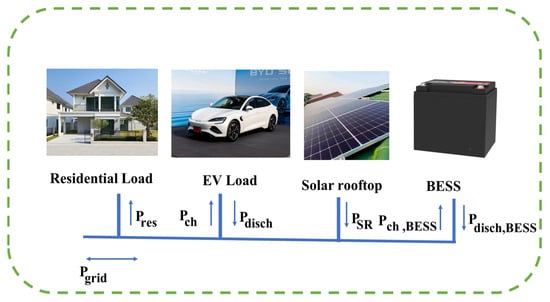
Figure 4.
Battery energy storage system for residential use.
The battery energy storage system for residential use, in the case of installing a charging system for electric vehicles, will be analyzed based on the amount of remaining usable energy.
From the solar rooftop system installed on the roof, the size of the battery energy storage system can be determined as shown in the equation [63]:
where:
- is the maximum power rating of the battery energy storage system;
- is Size of the battery energy storage system (kWh);
- is The Length of The Time Period: 0.25 h;
- t1 and t2 is the start and end time when the battery energy storage system is charging (h).
3. Simulation and Results
3.1. The Load Profile Collection of Residential
The collection of electricity consumption data from the Metropolitan Electricity Authority for residential applications from January 2022 to December 2023 will be recorded every 15 min through the dashboard system as a basis for forecasting, as shown in Figure 5. Energy consumption data from the charging system for electric vehicles (EV) of the wall charge type, with a capacity of 3.60 kW and a charging current of 16 A, is another type of electric consumption data with charging from 17.00 to 5.00, as shown in Figure 6. An analysis of the daily load from electricity consumption during EV charging, combined with residential electricity consumption, showed that the lowest electricity consumption of the month was 67.04 kWh, with electricity consumption at 33.67 kWh/day while electricity usage during the EV charging period was 33.37 kWh/day, as shown in Figure 7.
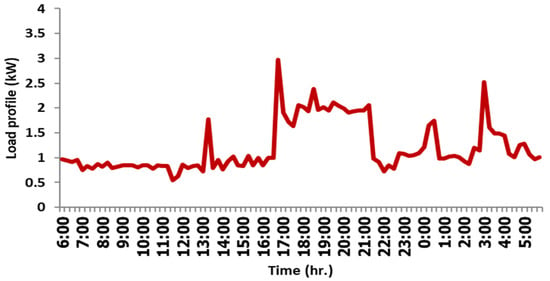
Figure 5.
Load profile of residential was 33.67 kWh/day.
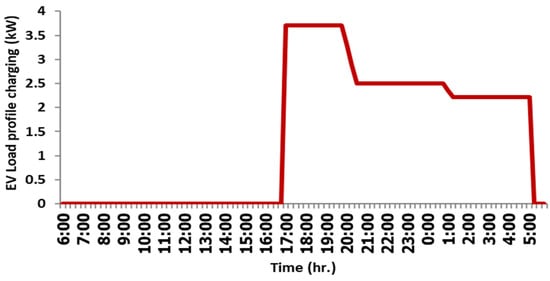
Figure 6.
EV Load profile charging was 33.37 kWh/day.
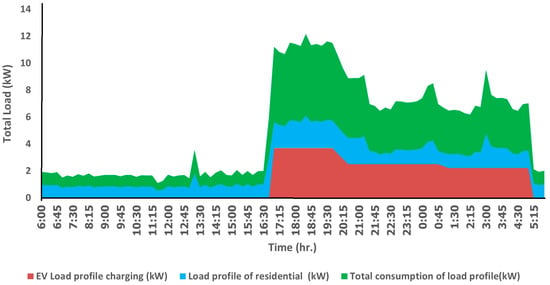
Figure 7.
Total consumption of load profile was 67.04 kWh/day.
3.2. Load Forecasting
3.2.1. Specifications for Developing an LSTM Model
The parameters utilized in an LSTM model primarily have two components: trainable parameters and hyperparameters. The parameters acquired by the LSTM model during training encompass the weights and biases of the LSTM layers. Hyperparameters are parameters established before model training that remain constant during the training process. In this study, the optimal hyperparameters obtained from Random Search are LSTM units = 50, batch size = 32, epochs = 20, optimizer = Adam, and learning rate = 0.001, which resulted in the lowest RMSE according to the experimental results. Therefore, using Random Search enhances the accuracy of electricity consumption forecasting by reducing computational time and efficiently identifying the optimal hyperparameters within a limited number of iterations. These parameters dictate the model’s performance. This investigation delineated the subsequent values. The types of parameters are shown in Table 1.

Table 1.
Types of LSTM parameters.
3.2.2. Data Training and Testing
The data used for the analysis consists of 730 sets, which were collected over a 24 month period from 1 January 2022 to 31 December 2023. The data was divided into two sets: the training set and the test set, with the last 30 sets of data used as the test set and the remaining data used as the training set. The data is arranged in chronological order to ensure that the model learns from the data in the correct temporal sequence, allowing for a comparison between the actual load and the forecasting load as shown in Figure 8.
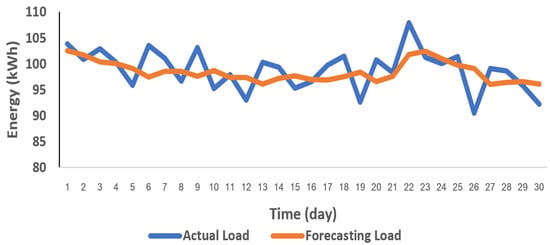
Figure 8.
Comparison of actual load and forecasting load.
3.2.3. Forecasting and Evaluation
The process of forecasting electricity consumption was carried out using a test set of 30 monthly data points, resulting in an RMSE value for the test set. (Test Set) which has the lowest error of long short-term memory. The Root Mean Squared Error (RMSE) is 3.554, allowing for a 30-day load forecast, as shown in Figure 9.
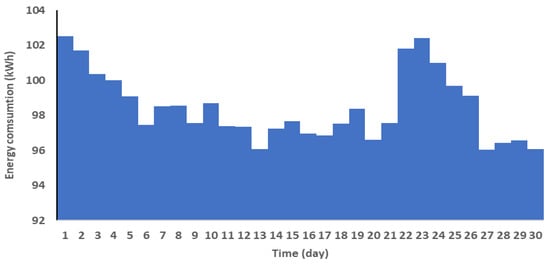
Figure 9.
Results of 30-day load forecast.
3.3. Battery Energy Storage System
Determining the size of the battery energy storage system will be based on actual load values and forecasted load values to compare the size of the battery energy storage system and determine the most suitable size. The battery energy storage system size, as shown in Figure 10.
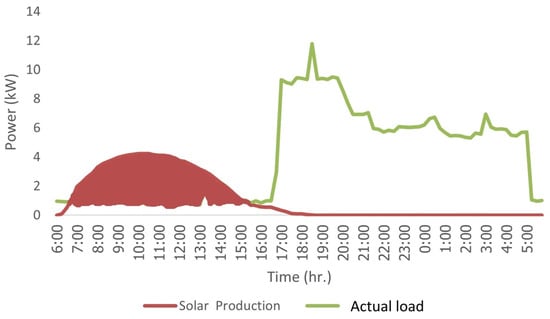
Figure 10.
The graph shows the battery energy storage system size equal to 21.03 kWh.
3.3.1. Actual Load
From the data on the lowest daily actual load energy consumption over the month, which includes residential electricity usage combined with electricity usage from charging electric vehicles, the total is 67.04 kWh, which allows us to determine the size of the battery energy storage system from the surplus electricity generated by the solar rooftop, amounting to 21.03 kWh. The BESS can reduce the peak power consumption (peak shaving) base on BESS size, as shown in Figure 11.
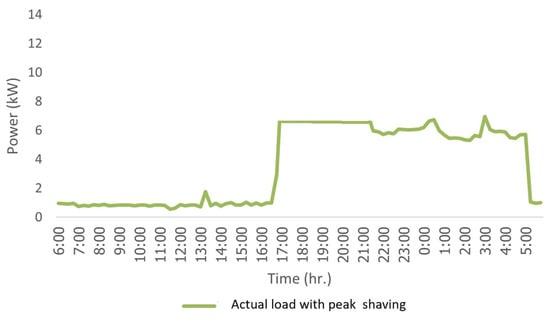
Figure 11.
The graph shows the reduction in peak power consumption (actual load) from the installation of battery energy storage system.
3.3.2. Load from the Forecast
Based on the 30-day load forecast, the battery energy storage system size will be determined from the day with the lowest load usage, which is 102.67 kWh, allowing us to determine the battery energy storage system size to be 17.84 kWh. And it can reduce the peak power consumption from the installation of the battery energy storage system as shown in Figure 12. The BESS can reduce the peak power consumption (peak shaving) base on BESS size as shown in Figure 13.
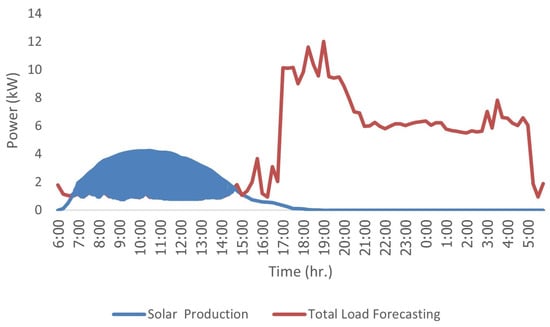
Figure 12.
The graph shows the battery energy storage system size to 17.84 kWh and the reduction in peak power consumption from the installation of battery energy storage system.
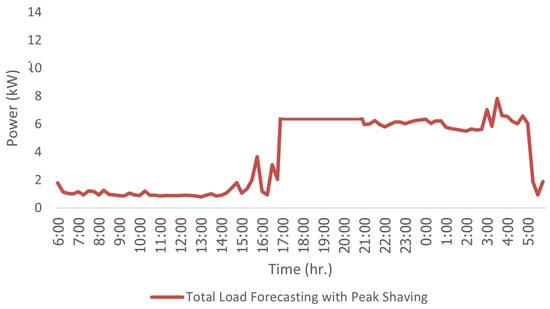
Figure 13.
The graph shows the reduction in peak power consumption (load forecasting) from the installation of battery energy storage system.
4. Conclusions
Battery energy storage systems suitable for residential use, in the case of installing charging systems for electric vehicles, are combined with load of residential and already installing a solar rooftop. The calculations and analysis were conducted using MATLAB 2019a for normal electric vehicle battery charging combined with load of residential. It was found that the residence used a total of 67.04 kWh of electricity. The solar rooftop system installed on the roof was 5.5 kWp, which produces an average of 28.78 kWh per day. The solar rooftop system produced additional electricity, which can be stored in a 21.04 kWh battery energy storage system. The load forecasting will be presented to find the appropriate size of BESS by considering the minimum daily load over the month, which is equal to 102.67 kWh, allowing us to determine the size of the BESS to be 17.84 kWh. When comparing the size of BESS from actual load values with the load from the forecasting, it can significantly reduce the size to 3.19 kWh and BESS costs to 12,839.75 baht (366.85 U.S.). In particular, the solar rooftop system can also reduce CO2 to 9.002 TonCO2/y.
Author Contributions
Methodology, S.P. and K.S.; Software, E.S.; Validation, C.K.; Formal analysis, N.P.; Supervision, P.U. All authors have read and agreed to the published version of the manuscript.
Funding
This research received no external funding.
Data Availability Statement
The data presented in this study can be obtained from the corresponding author due to privacy concerns.
Conflicts of Interest
The authors declare no conflict of interest.
References
- Fathia, C.; Zoubeyr, S.; Achour, M.; Madjid, C.; Smail, B. An energy flow management algorithm for a photovoltaic solar home. Energy Procedia 2017, 111, 934. [Google Scholar]
- Li, S.; He, H.; Chen, Y.; Huang, M.; Hu, C. Optimization Between the PV and the Retired EV Battery for the Residential Microgrid Application. Energy Procedia 2015, 75, 1138–1146. [Google Scholar] [CrossRef]
- Natarajan, P.; Pietro, E.C.; Amalorpavaraj, R.J.; Kaliannan, P. A new approach for grid integration of solar photovoltaic system with maximum power point tracking using multi-output converter. Energy Procedia 2019, 159, 521–526. [Google Scholar]
- Bounechba, H.; Bouzid, A.; Nabti, K.; Benalla, H. Comparison of perturb & observe and fuzzy logic in maximum power point tracker for PV systems. Energy Procedia 2014, 50, 677–684. [Google Scholar]
- Zhang, Q.; Wang, Z.; Shi, Y.; Qu, S. The optimal dispatch with combination of wind power and photovoltaic power systems. Energy Procedia 2016, 103, 94–99. [Google Scholar]
- Kante, V. An Investigation of Incremental Conductance Based Maximum Power Point Tracking For Photovoltaic System. Energy Procedia 2014, 54, 11–20. [Google Scholar]
- Evgenii, G.; Cedric, D.C.; Gilles, V.K.; Thierry, C.; Maarten, M. Forecasting flexibility of charging of electric vehicles: Tree and cluster-based Methods. Appl. Energy 2024, 353, 121969. [Google Scholar]
- Shahid, H. Hybrid coordination scheme based on fuzzy inference mechanism for residential charging of electric vehicles. Appl. Energy 2023, 352, 121939. [Google Scholar]
- Erotokritos, X.; Charalampos, M.; Liana, M.C.; Nick, J.; Steve, C.; Myles, B. A data driven approach for characterising the charging demand of electric vehicles: A UK case study. Appl. Energy 2016, 162, 763–771. [Google Scholar]
- Ulrich, F.; Mohammad, A.; Tobias, B. Temporal city-scale matching of solar photovoltaic generation and electric vehicle charging. Appl. Energy 2021, 282, 116160. [Google Scholar]
- Neaimeh, M. A probabilistic approach to combining smart meter and electric vehicle charging data to investigate distribution network impacts. Appl. Energy 2015, 157, 688–698. [Google Scholar] [CrossRef]
- Chandra Mouli, G.R.; Bauer, P.; Zeman, M. System design for a solar powered electric vehicle charging station for workplace. Appl. Energy 2016, 168, 434–443. [Google Scholar] [CrossRef]
- Li, Y.; Davis, C.; Lukszo, Z.; Margot, W. Electric vehicle charging in China’s power system: Energy, eco-nomic and environmental trade-offs and policy implications. Appl. Energy 2016, 173, 535–554. [Google Scholar] [CrossRef]
- Hasan, M. Dynamic and multi-stage capacity expansion planning in microgrid integrated with electric vehicle charging station. J. Energy Storage 2020, 29, 101351. [Google Scholar]
- Andre, L.; Markus, F.; Kevin, D.; Anna, L.K.; Michael, D.M. Optimizing electric vehicle fleet integration in industrial demand response: Maximizing vehicle-to-grid benefits while compensating vehicle owners for battery degradation. Appl. Energy 2024, 374, 123995. [Google Scholar]
- Pablo, D.C.; Jose, I.M.; Javier, C. Integrated operational planning model, considering optimal delivery routing, incentives and electric vehicle aggregated demand management. Appl. Energy 2021, 304, 117698. [Google Scholar]
- Benedikt, T.; Jan, F.; Stefan, E.; Dirk, U.S.; Andreas, J.; Holger, H. Optimal pool composition of commercial electric vehicles in V2G fleet operation of various electricity markets. Appl. Energy 2022, 308, 118351. [Google Scholar]
- Muhandiram, A.S.; Tharangi, I.; Peter, K. Uncertainties in model predictive control for decentralized autonomous demand side management of electric vehicles. J. Energy Storage 2024, 83, 110194. [Google Scholar]
- Muhammad, A.; Abhisek, U. Battery degradation model of electric vehicle with grid integration. J. Energy Storage 2024, 97, 112709. [Google Scholar]
- Fabian, R.; Jan, F.; Ilka, S.; Dirk, U.S. Battery Electric Vehicles in Commercial Fleets: Use profiles, battery aging and open-access data. J. Energy Storage 2024, 86, 111030. [Google Scholar]
- Lindiwe, B.; Kanzumba, K.; Herman, V.; Andrew, H. Optimal power dispatching for a grid-connected electric vehicle charging station microgrid with renewable energy, battery storage and peer-to-peer energy sharing. J. Energy Storage 2024, 96, 112435. [Google Scholar]
- Swantje, G.; Katrin, M.; Mark, B.; Bernd, H. Acceptance of Ancillary Services and Willingness to Invest in PV-storage-systems. Energy Procedia 2015, 73, 29–36. [Google Scholar]
- Johannes, W.; Tjarko, T.; Volker, Q. Sizing of residential PV battery systems. Energy Procedia 2014, 46, 78–87. [Google Scholar]
- Alexander, Z.; Rolf, W. Operational strategies for battery storage systems in low-voltage distribution grids to limit the feed-in power of roof-mounted solar power systems. Energy Procedia 2014, 46, 114–123. [Google Scholar]
- Peter, S.; Jochen, L.; Johannes, F. Impact of Different Load Profiles on Cost Optimal System Designs for Battery Supported PV Systems. Energy Procedia 2015, 75, 1862–1868. [Google Scholar]
- Sichilalu, S.M.; Xia, X. Optimal power control of grid tied PV-battery-diesel system powering heat pump water heaters. Energy Procedia 2015, 75, 1514–1521. [Google Scholar] [CrossRef]
- Simani, K.N.; Genga, Y.O.; Yen, Y.-C.J. Using LSTM to Perform Load Predictions for Grid-Interactive Buildings. Afr. Res. J. 2024, 115, 42–47. [Google Scholar] [CrossRef]
- Fayaz, A.; Ammar, A.; Attique, U.R. Comparative Analysis of Time Series Forecasting of a Household Load Consumption with LSTM Neural Networks and XGBoost Model. In Proceedings of the International Conference on Engineering & Computing Technologies (ICECT), Islamabad, Pakistan, 23 May 2024. [Google Scholar]
- Feng, C.; Shao, L.; Wang, J.; Zhang, Y.; Wen, F. Short-term Load Forecasting of Distribution Transformer Supply Zones Based on Federated Model-Agnostic Meta Learning. IEEE Trans. Power Syst. 2025, 40, 31–45. [Google Scholar] [CrossRef]
- Establishment of Thailand Greenhouse Gas Management Organization (Public Organization). Emission Faction Report. 2023. Available online: https://ghgreduction.tgo.or.th (accessed on 1 November 2024).
- Jarvis, P.; Climent, L.; Arbelaez, A. Smart and sustainable scheduling of charging events for electric buses. TOP 2024, 32, 22–56. [Google Scholar] [CrossRef]
- Fahd, S.A.; Ahmad, A.A. Enhancing environmental sustainability with federated LSTM models for AI-driven optimization. Alex. Eng. J. 2024, 108, 640–653. [Google Scholar]
- Faizan, Y.; Ali, R.; Nisrean, T.; Laith, A.; Raed, A.Z.; Heming, J. An efficient artificial intelligence approach for early detection of cross-site scripting attacks. Decis. Anal. J. 2024, 11, 100466. [Google Scholar]
- Toqeer, A.S.; Muhammad, Y.K.; Salman, J.; Sami, A.; Saad, S.A.; Muhammad, T.N. Integrating Digital Twins and Artificial Intelligence Multi-Modal Transformers into Water Resource Management: Overview and Advanced Predictive Framework. AI 2024, 5, 1977–2017. [Google Scholar] [CrossRef]
- Ilyass, B.; Afaf, B.; Ahmed, Z. Enhancing Traffic Accident Severity Prediction Using Res Net and SHAP for Interpretability. AI 2024, 5, 2568–2585. [Google Scholar] [CrossRef]
- Sakorn, M.; Anuchit, J.A. Deep Learning Network with Aggregation Residual Transformation for Human Activity Recognition Using Inertial and Stretch Sensors. Computers 2023, 12, 141. [Google Scholar] [CrossRef]
- Alaa, E.; Ebrahim, A. Electrocardiogram Signals Classification Using Deep-Learning-Based Incorporated Convolutional Neural Network and Long Short-Term Memory Framework. Computers 2024, 13, 55. [Google Scholar] [CrossRef]
- Elias, D.; Maria, T. Application of Deep Learning for Heart Attack Prediction with Explainable Artificial Intelligence. Computers 2024, 13, 244. [Google Scholar] [CrossRef]
- Tuan, A.T.; Tamás, R.; János, A. The Use of eXplainable Artificial Intelligence and Machine Learning Operation Principles to Support the Continuous Development of Machine Learning-Based Solutions in Fault Detection and Identification. Computers 2024, 13, 252. [Google Scholar] [CrossRef]
- Xu, C.; Li, C.; Zhou, X. Interpretable LSTM Based on Mixture Attention Mechanism for Multi-Step Residential Load Forecasting. Electronics 2022, 11, 2189. [Google Scholar] [CrossRef]
- Yang, J.; Hu, J.; Yu, T. Federated AI-Enabled In-Vehicle Network Intrusion Detection for Internet of Vehicles. Electronics 2022, 11, 3658. [Google Scholar] [CrossRef]
- Alzahrani, A.; Aldhyani, T.H. Aldhyani. Artificial Intelligence Algorithms for Detecting and Classifying MQTT Protocol Internet of Things Attacks. Electronics 2022, 11, 3837. [Google Scholar] [CrossRef]
- Peng, H.; Zhang, X.; Li, H.; Xu, L.; Wang, X. An AI-Enhanced Strategy of Service Offloading for IoV in Mobile Edge Computing. Electronics 2023, 12, 2719. [Google Scholar] [CrossRef]
- Huang, Z.; Ma, Y.; Wang, R.; Li, W.; Dai, Y. A Model for EEG-Based Emotion Recognition: CNN-Bi-LSTM with Attention Mechanism. Electronics 2023, 12, 3188. [Google Scholar] [CrossRef]
- Alonazi, M.; Alshahrani, H.J.; Alotaibi, F.A.; Maray, M.; Alghamdi, M.; Sayed, A. Automated Facial Emotion Recognition Using the Pelican Optimization Algorithm with a Deep Convolutional Neural Network. Electronics 2023, 12, 4608. [Google Scholar] [CrossRef]
- Wang, L.; Chen, Z.; Liu, W.; Huang, H. A Temporal–Geospatial Deep Learning Framework for Crop Yield Prediction. Electronics 2024, 13, 4273. [Google Scholar] [CrossRef]
- Alkahtani, H.; Aldhyani, T.H.; Alsubari, S.N. Application of Artificial Intelligence Model Solar Radiation Prediction for Renewable Energy Systems. Sustainability 2023, 15, 6973. [Google Scholar] [CrossRef]
- Zabin, R.; Haque, K.F.; Abdelgawad, A. PredXGBR: A Machine Learning Framework for Short-Term Electrical Load Prediction. Electronics 2024, 13, 4521. [Google Scholar] [CrossRef]
- Lee, D.; Koo, S.; Jang, I.; Kim, J. Comparison of Deep Reinforcement Learning and PID Con-trollers for Automatic Cold Shutdown Operation. Energies 2022, 15, 2834. [Google Scholar] [CrossRef]
- Liu, B.; Lei, J.; Xie, J.; Zhou, J. Development and Validation of a Nuclear Power Plant Fault Diagno-sis System Based on Deep Learning. Energies 2022, 15, 8629. [Google Scholar] [CrossRef]
- Kong, X.; Liu, Y.; Xue, L.; Li, G.; Zhu, D. A Hybrid Oil Production Prediction Model Based on Artificial Intelligence Technology. Energies 2023, 16, 1027. [Google Scholar] [CrossRef]
- Su, C.; Yang, Q.; Wu, X.; Lai, C.S.; Lai, L.L. A Two-Terminal Fault Location Fusion Model of Transmission Line Based on CNN-Multi-Head-LSTM with an Attention Module. Energies 2023, 16, 1827. [Google Scholar] [CrossRef]
- Osman, U.; Mehmet, S.B.; Melih, K. Raster Angle Prediction of Additive Manufacturing Process Using Machine Learning Algorithm. Appl. Sci. 2024, 14, 2046. [Google Scholar] [CrossRef]
- Chi, D.J.; Chu, C.C. Artificial Intelligence in Corporate Sustainability: Using LSTM and GRU for Going Concern Prediction. Sustainability 2021, 13, 11631. [Google Scholar] [CrossRef]
- Asaad, M.N.; Eryürük, Ş.; Eryürük, K. Forecasting of Streamflow and Comparison of Artificial Intelligence Methods: A Case Study for Meram Stream in Konya, Turkey. Sustainability 2022, 14, 6319. [Google Scholar] [CrossRef]
- Li, K.; Wang, K.; Tang, C.; Pan, Y.; He, Y.; Cai, S.; Chen, S.; Zhou, Y. Prediction of Key De-velopment Indicators for Offshore Oilfields Based on Artificial Intelligence. Energies 2024, 17, 4594. [Google Scholar] [CrossRef]
- Pir, D.S.; Xianping, F.; Muhammad, A.; Dani, E.M.; Arsalan, A. Deep Q Network Based on a Fractional Political–Smart Flower Optimization Algorithm for Real-World Object Recognition in Federated Learning. Appl. Sci. 2023, 13, 13286. [Google Scholar] [CrossRef]
- Li, E.; Wang, Z.; Liu, J.; Huang, J. Renewal of the Concept of Diverse Education: Possibility of Further Education Based on a Novel AI-Based RF–ISSA Model. Appl. Sci. 2025, 15, 250. [Google Scholar] [CrossRef]
- Stergiou, K.; Karakasidis, T. Optimizing Renewable Energy Systems Placement Through Advanced Deep Learning and Evolutionary Algorithms. Appl. Sci. 2024, 14, 10795. [Google Scholar] [CrossRef]
- Tamer, D. A Comparison of the Use of Artificial Intelligence Methods in the Estimation of Thermoluminescence Glow Curves. Appl. Sci. 2023, 13, 13027. [Google Scholar] [CrossRef]
- Mo, C.; Jiang, C.; Lei, X.; Lai, S.; Deng, Y.; Cen, W.; Sun, G.; Xing, Z. Combining Standard Artificial Intelligence Models, Pre-Processing Techniques, and Post-Processing Methods to Improve the Accuracy of Monthly Runoff Predictions in Karst-Area Watersheds. Appl. Sci. 2023, 13, 88. [Google Scholar] [CrossRef]
- Mohsen, B.; Hossein, B.H.; Mehdi, T.; Mohammad, K.; Esmail, K.; Jacek, D. Forecasting of Power Output of a PVPS Based on Meteorological Data Using RNN Approaches. Sustainability 2022, 14, 3104. [Google Scholar] [CrossRef]
- Pramuk, U.; Panot, S. Reduction of Reverse Power Flow Using the Appropriate Size and Installation Position of a BESS for a PV Power Plant. IEEE Access 2020, 8, 102897–102906. [Google Scholar]
Disclaimer/Publisher’s Note: The statements, opinions and data contained in all publications are solely those of the individual author(s) and contributor(s) and not of MDPI and/or the editor(s). MDPI and/or the editor(s) disclaim responsibility for any injury to people or property resulting from any ideas, methods, instructions or products referred to in the content. |
© 2025 by the authors. Licensee MDPI, Basel, Switzerland. This article is an open access article distributed under the terms and conditions of the Creative Commons Attribution (CC BY) license (https://creativecommons.org/licenses/by/4.0/).